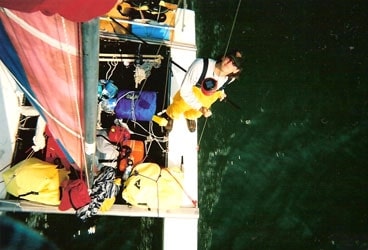
ASHobie368b
I’d sailed Hobie 16s as a teenager, and I’d longed for a Miracle 20 for what seemed like forever, when I finally found one I could afford in December 2005. For $600, I got a 1993 model with about 10 holes in each hull-which were full of sand-the transom ripped out, and no rudders. Needless to say, it was a fixer-upper.
At the time, I was spending the winter aboard a Catalina 27 in St. Augustine, Florida, with my wife, Rachel, and my daughters Selene and Phoebe. During that time, I restored the Miracle 20, and since we have a home base near Fredericksburg, Virginia, I thought it would be a great idea to sail it up to Fredericksburg with my cousin, Eric Townsend, who-if he’d had any prior sailing experience-would’ve never agreed to the trip.
Since we’d decided that we wanted this trip to be more of a challenging adventure than a pleasure cruise, we chose not to rely on a land-support crew who would have met up with us at spots along the way every night. This meant we had to carry enough navigational equipment, camping gear, tools for emergencies, and enough food and water to last for about eight days and 1,050 miles. We also had to bring ground tackle to anchor the boat out because most of the shoreline between Florida and Virginia has about six feet of tide and lots of rocks, shells, and other debris that would damage the bottom of the boat. We also mounted a 5-horespower outboard, which added extra weight, so we only carried enough fuel for one day at a time, planning to sail a much as possible.
We left on a rainy day in late April 2006 with a strong north wind blowing, so we decided to travel the Intracoastal Waterway. We didn’t make much headway, but we found a great campsite on a beach and slept soundly. The next day, we tried to head out to sea again, but the wind was still blowing from the north at 20 to 25 knots, so we stuck to the ICW. And this was our pattern for several days.
As we approached Port Royal Sound, off the southern tip of South Carolina, we were relieved when the wind took an easterly turn. This allowed us to sail at lightning speed with a reef in the main and full jib. Alas, this was short-lived, as the wind shifted the next day and was once again blowing harshly from the north. And this was our pattern-again-all the way to Beaufort, North Carolina.
We were tired and hungry as we inched toward Beaufort. Night was falling, and on our handheld VHF we heard about a fast-approaching nor’easter with gusts up to 50. With little food or fuel left, and no chance of crossing Pamlico Sound in such conditions, we decided to buckle down in Beaufort until more favorable weather returned. Eric and I were lucky to find some kind souls in the local boating community who gave us a dry place to sleep and much-needed hot showers.
For the next five days, storms raged with winds gusting from 30 to 60 knots. When the weather finally subsided, we bought some food, fuel, and prepared to set off again. My family was back in Virginia, and my wife was almost nine months pregnant. With the due date fast approaching, and no time to lose, we continued on our journey.
On the morning we left Beaufort, the wind was out of the north-again- and blowing between 10 and 15 knots. This wasn’t ideal for crossing Pamlico Sound, but we pressed on. As the day progressed, the wind picked up to nearly 35 knots. With only the headsail up, we continued across Pamlico despite heavy winds and large waves. When we reached the other side it was still fairly early, but-thankful to be alive-we decided to call it a day and set up camp on the banks of Albermarle Sound. We planned on making it to Norfolk, Virginia, the next day, which is where our charts ended. We got little sleep that night, worried about what the following day would bring.
We left at first light and did make it as far as Norfolk in the now all-too-familiar rough weather and north wind. I thought about getting more charts while we were there, but we were out of money, and my wife’s due date was that much closer. I’d had some experience sailing the Chesapeake, so Eric and I decided to just forge ahead.
Just by chance, (was our luck finally changing?) we ran into a cruising couple that night whom I’d met on the water years before. I examined their charts and tried to memorize everything I could about finding the mouth of the Rappahannock River. There are several wrong left-hand turns one could make, but the river has a large bridge that crosses it about six miles up from the mouth.
We left the next morning, knowing that we would have to navigate about 50 miles of the Chesapeake and find the mouth of the Rappahannock with no charts and just my questionable memory. Thankfully-and finally-the wind turned southeast and blew 15 to 20 knots. We flew the whole way under full sail, and we found the mouth of the Rappahannock on the first shot. We retired for the evening a few miles up the river.
The next day brought us great weather again, and we arrived sunburned and tired at the City Dock in Fredericksburg on May 15. Overall, the trip took 17 days, and our original idea of a embarking on a challenging journey as opposed to just a pleasure cruise was realized beyond our wildest dreams; yet, Eric still likes me. He might even go sailing with me again someday. And my daughter, Josie, arrived three weeks later. I guess we had plenty of time after all.







